Zheyu Chen
NLGCL: Naturally Existing Neighbor Layers Graph Contrastive Learning for Recommendation
Jul 10, 2025Abstract:Graph Neural Networks (GNNs) are widely used in collaborative filtering to capture high-order user-item relationships. To address the data sparsity problem in recommendation systems, Graph Contrastive Learning (GCL) has emerged as a promising paradigm that maximizes mutual information between contrastive views. However, existing GCL methods rely on augmentation techniques that introduce semantically irrelevant noise and incur significant computational and storage costs, limiting effectiveness and efficiency. To overcome these challenges, we propose NLGCL, a novel contrastive learning framework that leverages naturally contrastive views between neighbor layers within GNNs. By treating each node and its neighbors in the next layer as positive pairs, and other nodes as negatives, NLGCL avoids augmentation-based noise while preserving semantic relevance. This paradigm eliminates costly view construction and storage, making it computationally efficient and practical for real-world scenarios. Extensive experiments on four public datasets demonstrate that NLGCL outperforms state-of-the-art baselines in effectiveness and efficiency.
MDVT: Enhancing Multimodal Recommendation with Model-Agnostic Multimodal-Driven Virtual Triplets
May 22, 2025Abstract:The data sparsity problem significantly hinders the performance of recommender systems, as traditional models rely on limited historical interactions to learn user preferences and item properties. While incorporating multimodal information can explicitly represent these preferences and properties, existing works often use it only as side information, failing to fully leverage its potential. In this paper, we propose MDVT, a model-agnostic approach that constructs multimodal-driven virtual triplets to provide valuable supervision signals, effectively mitigating the data sparsity problem in multimodal recommendation systems. To ensure high-quality virtual triplets, we introduce three tailored warm-up threshold strategies: static, dynamic, and hybrid. The static warm-up threshold strategy exhaustively searches for the optimal number of warm-up epochs but is time-consuming and computationally intensive. The dynamic warm-up threshold strategy adjusts the warm-up period based on loss trends, improving efficiency but potentially missing optimal performance. The hybrid strategy combines both, using the dynamic strategy to find the approximate optimal number of warm-up epochs and then refining it with the static strategy in a narrow hyper-parameter space. Once the warm-up threshold is satisfied, the virtual triplets are used for joint model optimization by our enhanced pair-wise loss function without causing significant gradient skew. Extensive experiments on multiple real-world datasets demonstrate that integrating MDVT into advanced multimodal recommendation models effectively alleviates the data sparsity problem and improves recommendation performance, particularly in sparse data scenarios.
Squeeze and Excitation: A Weighted Graph Contrastive Learning for Collaborative Filtering
Apr 06, 2025



Abstract:Contrastive Learning (CL) has recently emerged as a powerful technique in recommendation systems, particularly for its capability to harness self-supervised signals from perturbed views to mitigate the persistent challenge of data sparsity. The process of constructing perturbed views of the user-item bipartite graph and performing contrastive learning between perturbed views in a graph convolutional network (GCN) is called graph contrastive learning (GCL), which aims to enhance the robustness of representation learning. Although existing GCL-based models are effective, the weight assignment method for perturbed views has not been fully explored. A critical problem in existing GCL-based models is the irrational allocation of feature attention. This problem limits the model's ability to effectively leverage crucial features, resulting in suboptimal performance. To address this, we propose a Weighted Graph Contrastive Learning framework (WeightedGCL). Specifically, WeightedGCL applies a robust perturbation strategy, which perturbs only the view of the final GCN layer. In addition, WeightedGCL incorporates a squeeze and excitation network (SENet) to dynamically weight the features of the perturbed views. Our WeightedGCL strengthens the model's focus on crucial features and reduces the impact of less relevant information. Extensive experiments on widely used datasets demonstrate that our WeightedGCL achieves significant accuracy improvements compared to competitive baselines.
COHESION: Composite Graph Convolutional Network with Dual-Stage Fusion for Multimodal Recommendation
Apr 06, 2025



Abstract:Recent works in multimodal recommendations, which leverage diverse modal information to address data sparsity and enhance recommendation accuracy, have garnered considerable interest. Two key processes in multimodal recommendations are modality fusion and representation learning. Previous approaches in modality fusion often employ simplistic attentive or pre-defined strategies at early or late stages, failing to effectively handle irrelevant information among modalities. In representation learning, prior research has constructed heterogeneous and homogeneous graph structures encapsulating user-item, user-user, and item-item relationships to better capture user interests and item profiles. Modality fusion and representation learning were considered as two independent processes in previous work. In this paper, we reveal that these two processes are complementary and can support each other. Specifically, powerful representation learning enhances modality fusion, while effective fusion improves representation quality. Stemming from these two processes, we introduce a COmposite grapH convolutional nEtwork with dual-stage fuSION for the multimodal recommendation, named COHESION. Specifically, it introduces a dual-stage fusion strategy to reduce the impact of irrelevant information, refining all modalities using ID embedding in the early stage and fusing their representations at the late stage. It also proposes a composite graph convolutional network that utilizes user-item, user-user, and item-item graphs to extract heterogeneous and homogeneous latent relationships within users and items. Besides, it introduces a novel adaptive optimization to ensure balanced and reasonable representations across modalities. Extensive experiments on three widely used datasets demonstrate the significant superiority of COHESION over various competitive baselines.
Don't Lose Yourself: Boosting Multimodal Recommendation via Reducing Node-neighbor Discrepancy in Graph Convolutional Network
Dec 25, 2024Abstract:The rapid expansion of multimedia contents has led to the emergence of multimodal recommendation systems. It has attracted increasing attention in recommendation systems because its full utilization of data from different modalities alleviates the persistent data sparsity problem. As such, multimodal recommendation models can learn personalized information about nodes in terms of visual and textual. To further alleviate the data sparsity problem, some previous works have introduced graph convolutional networks (GCNs) for multimodal recommendation systems, to enhance the semantic representation of users and items by capturing the potential relationships between them. However, adopting GCNs inevitably introduces the over-smoothing problem, which make nodes to be too similar. Unfortunately, incorporating multimodal information will exacerbate this challenge because nodes that are too similar will lose the personalized information learned through multimodal information. To address this problem, we propose a novel model that retains the personalized information of ego nodes during feature aggregation by Reducing Node-neighbor Discrepancy (RedN^nD). Extensive experiments on three public datasets show that RedN^nD achieves state-of-the-art performance on accuracy and robustness, with significant improvements over existing GCN-based multimodal frameworks.
AlignGroup: Learning and Aligning Group Consensus with Member Preferences for Group Recommendation
Sep 04, 2024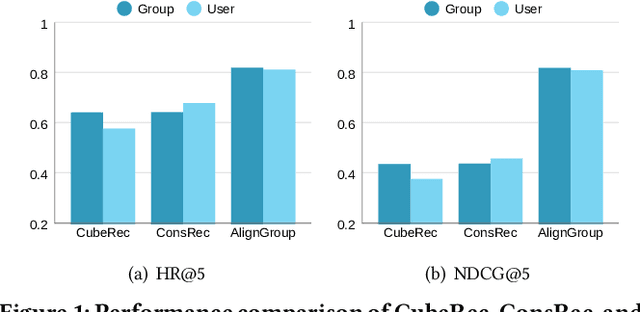

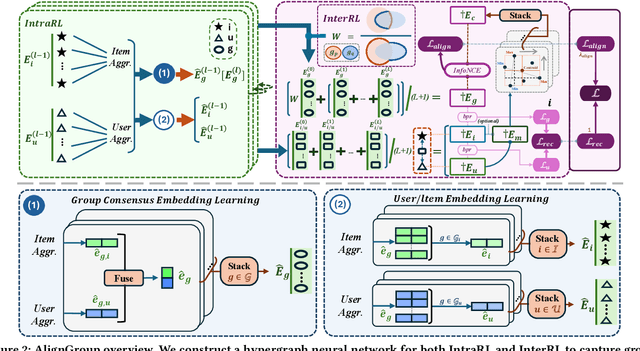

Abstract:Group activities are important behaviors in human society, providing personalized recommendations for groups is referred to as the group recommendation task. Existing methods can usually be categorized into two strategies to infer group preferences: 1) determining group preferences by aggregating members' personalized preferences, and 2) inferring group consensus by capturing group members' coherent decisions after common compromises. However, the former would suffer from the lack of group-level considerations, and the latter overlooks the fine-grained preferences of individual users. To this end, we propose a novel group recommendation method AlignGroup, which focuses on both group consensus and individual preferences of group members to infer the group decision-making. Specifically, AlignGroup explores group consensus through a well-designed hypergraph neural network that efficiently learns intra- and inter-group relationships. Moreover, AlignGroup innovatively utilizes a self-supervised alignment task to capture fine-grained group decision-making by aligning the group consensus with members' common preferences. Extensive experiments on two real-world datasets validate that our AlignGroup outperforms the state-of-the-art on both the group recommendation task and the user recommendation task, as well as outperforms the efficiency of most baselines.
FourierKAN-GCF: Fourier Kolmogorov-Arnold Network -- An Effective and Efficient Feature Transformation for Graph Collaborative Filtering
Jun 04, 2024
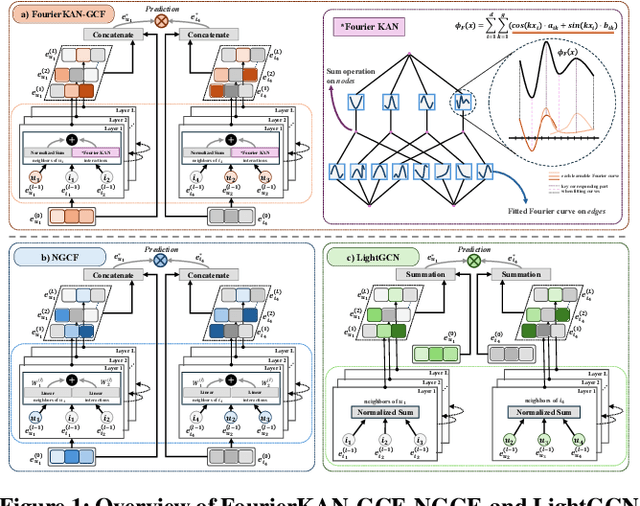
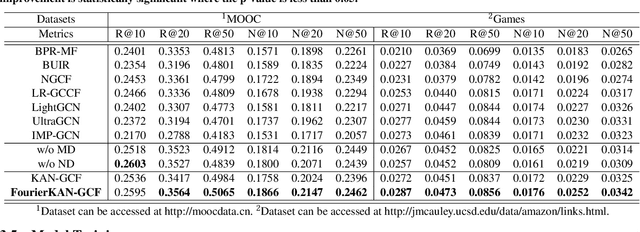
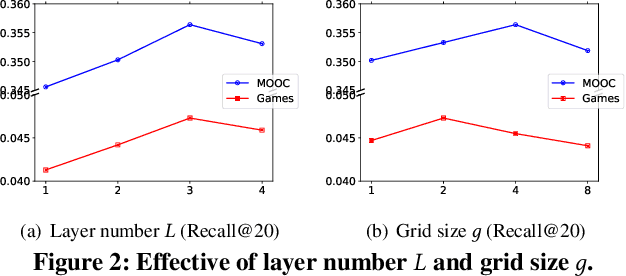
Abstract:Graph Collaborative Filtering (GCF) has achieved state-of-the-art performance for recommendation tasks. However, most GCF structures simplify the feature transformation and nonlinear operation during message passing in the graph convolution network (GCN). We revisit these two components and discover that a part of feature transformation and nonlinear operation during message passing in GCN can improve the representation of GCF, but increase the difficulty of training. In this work, we propose a simple and effective graph-based recommendation model called FourierKAN-GCF. Specifically, it utilizes a novel Fourier Kolmogorov-Arnold Network (KAN) to replace the multilayer perceptron (MLP) as a part of the feature transformation during message passing in GCN, which improves the representation power of GCF and is easy to train. We further employ message dropout and node dropout strategies to improve the representation power and robustness of the model. Extensive experiments on two public datasets demonstrate the superiority of FourierKAN-GCF over most state-of-the-art methods. The implementation code is available at https://github.com/Jinfeng-Xu/FKAN-GCF.
MENTOR: Multi-level Self-supervised Learning for Multimodal Recommendation
Feb 29, 2024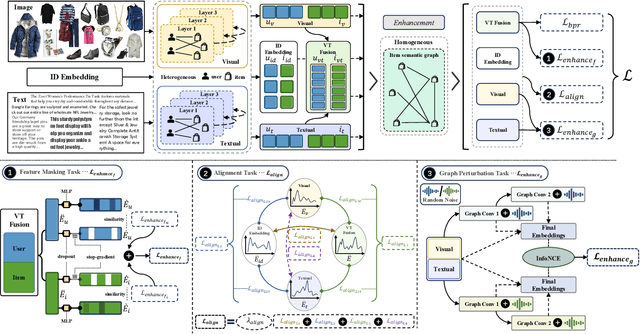


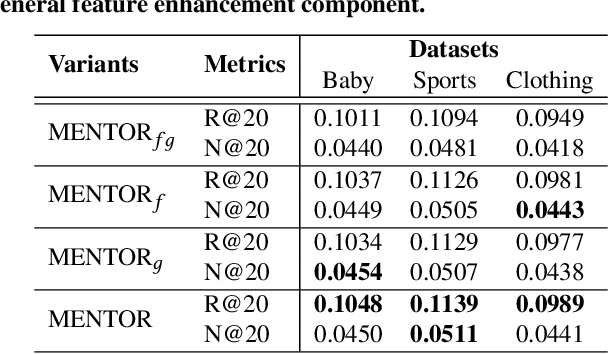
Abstract:With the increasing multimedia information, multimodal recommendation has received extensive attention. It utilizes multimodal information to alleviate the data sparsity problem in recommendation systems, thus improving recommendation accuracy. However, the reliance on labeled data severely limits the performance of multimodal recommendation models. Recently, self-supervised learning has been used in multimodal recommendations to mitigate the label sparsity problem. Nevertheless, the state-of-the-art methods cannot avoid the modality noise when aligning multimodal information due to the large differences in the distributions of different modalities. To this end, we propose a Multi-level sElf-supervised learNing for mulTimOdal Recommendation (MENTOR) method to address the label sparsity problem and the modality alignment problem. Specifically, MENTOR first enhances the specific features of each modality using the graph convolutional network (GCN) and fuses the visual and textual modalities. It then enhances the item representation via the item semantic graph for all modalities, including the fused modality. Then, it introduces two multilevel self-supervised tasks: the multilevel cross-modal alignment task and the general feature enhancement task. The multilevel cross-modal alignment task aligns each modality under the guidance of the ID embedding from multiple levels while maintaining the historical interaction information. The general feature enhancement task enhances the general feature from both the graph and feature perspectives to improve the robustness of our model. Extensive experiments on three publicly available datasets demonstrate the effectiveness of our method. Our code is publicly available at https://github.com/Jinfeng-Xu/MENTOR.
Learning Rich Image Region Representation for Visual Question Answering
Oct 29, 2019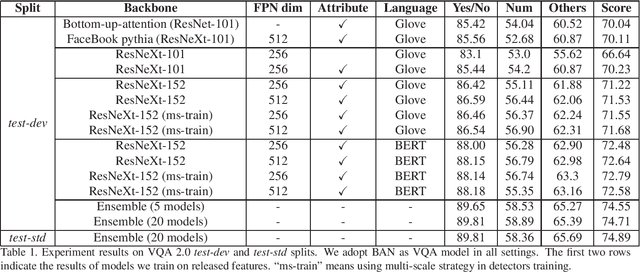
Abstract:We propose to boost VQA by leveraging more powerful feature extractors by improving the representation ability of both visual and text features and the ensemble of models. For visual feature, some detection techniques are used to improve the detector. For text feature, we adopt BERT as the language model and find that it can significantly improve VQA performance. Our solution won the second place in the VQA Challenge 2019.
 Add to Chrome
Add to Chrome Add to Firefox
Add to Firefox Add to Edge
Add to Edge